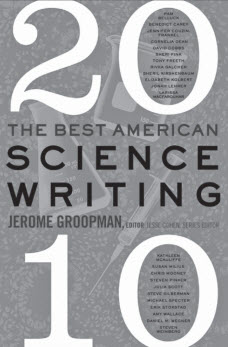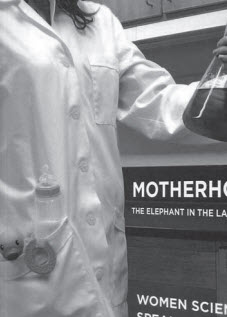
EDITOR JESSE COHEN. NEW YORK, NY: ECCO; 2010. 346 PAGES. SOFTCOVER $14.99. ISBN-13: 978-0-06-185251-0.
With this volume, the annual series Best American Science Writingenters its second decade. The articles in the volume, like those in its predecessors, tend to be long, to contain considerable narrative (some of it first person), and to come largely from Northeast-based magazines and newspapers. Articles on biology or medicine predominate.
Whether the articles are truly the best— or even representative of the best—is, of course, open to debate. But this 22-article collection does contain outstanding work. Favorites of the science-journalism graduate class to which I assigned this book, and of mine, include
- “The Orchid Children” (by David Dobbs in The Atlantic), which presents with vivid imagery the hypothesis that certain genetic behavioral traits may be disadvantageous in some environments and advantageous in others.
- “The Famine Fighter’s Last Battle” (by Erik Stokstad in Science), a tightly written profile of scientist Norman Borlaug.
- “The Sixth Extinction?” (by Elizabeth Kolbert in The New Yorker), an exhaustive exploration that takes the author to frog habitats in Panama and a bat cave in Vermont to learn about the mass extinction that now seems under way.
- “A Most Private Evolution” (by Susan Milius in Science News), an informative and witty account of strange sex organs that have evolved.
The articles chosen for this book are extensively researched, skillfully crafted, and well edited. At least one of the articles mentions the role of an editor— in helping the author to obtain a hardto-get interview. As in past years, the volume editor is a prominent writer about science (this time Jerome Groopman), and the series editor is writer and freelance editor Jesse Cohen. Perhaps interviewing Cohen about his role in shaping the series could yield an engaging piece for Science Editor.
BARBARA GASTEL coordinates the sciencejournalism graduate program at Texas A&M University and is knowledge-community editor for AuthorAID at INASP (www.authoraid.info).

NY: ILR PRESS; 2010. 219 PAGES.
PAPERBACK $17.95. ISBN-13: 978-0-8014-7669-3.
Thirty-four women who chose careers in science and also chose to become mothers write about their personal experiences in Motherhood, the Elephant in the Laboratory. This collection of essays is arranged by the decade in which the contributors earned their graduate degrees in science or engineering. In the 1970s, only 17% of the PhDs in these fields were awarded to women. By the 1980s, women wanted it all—high-powered careers and families. The number of women faculty in science and engineering peaked in the 1990s but declined in the 2000s as women began to seek more balance between their careers and their families.
In the introduction, Editor Monosson writes, “What sets science and academics apart from other professions when it comes to having children is the requirement for many PhD graduates to complete at least one postdoctoral position before moving into a more permanent job, particularly for those in research, delaying the timing of career stability. When a woman is striving for tenure or career stability (typically in her midthirties), the biological clock is winding down.” The introduction also addresses, for the purposes of this book, who was considered a scientist, what constituted a professional career in science, and how success as a scientist should be defined.
Recurring themes from the contributors include mothers’ guilt over neglecting family or having to “settle” for something other than a “traditional” job (tenure-track position in academia) or career in science, the best time for a woman to have children (in graduate school when time is more flexible but money is tight, as a postdoc, or before or after tenure), the sometimes limited options faced by women who “opt out” of a science career to have children and then opt back in later, juggling two-career families in which both are in science, and the stress in searching for that elusive balance between a science profession and family life.
Although opportunities for women in science have improved over the last 40 years, the contributors’ experiences illustrate the challenges of being both a dedicated scientist and a dedicated mother.
SUSAN M SHIRLEY is a freelance science editor in Corpus Christi, Texas.
Book Alert
THE CHANGING FACE OF MEDICINE: WOMEN DOCTORS AND THE EVOLUTION OF HEALTH CARE IN AMERICA. ANN K BOULIS AND JERRY A JACOBS. ITHACA, NY: ILR PRESS; 2010. 266 PAGES. PAPERBACK $21.00. ISBN-13: 978-0- 8014-4446-3.
This book is an exploration of multiple aspects of the steady growth in the number of women in medical schools, residencies, and medical practice, including societal developments, immigration, economics, and the women’s movement. The authors examine common assumptions about women in medicine and address such issues as specialty choice, time spent with patients, the rapidly evolving medical system, and shifts in gender roles.
THE DISAPPEARING SPOON: AND OTHER TRUE TALES OF MADNESS, LOVE, AND THE HISTORY OF THE WORLD FROM THE PERIODIC TABLE OF THE ELEMENTS. SAM KEAN. BOSTON, MA: LITTLE BROWN AND COMPANY; 2010. 400 PAGES. HARDCOVER $24.99. ISBN-13: 978-0-3160-5164-4.
Kean, a reporter for Science, fascinates with a history of the periodic table and the tantalizing tales and details surrounding the discovery of 112 elements and their roles in human history, finance, mythology, war, the arts, poison, and the lives of the scientists who discovered them. Who knew that the periodic table was so full of scandal, intrigue, and humor?
FREELANCING EXPERTISE: CONTRACT PROFESSIONALS IN THE NEW ECONOMY. DEBRA OSNOWITZ. ITHACA, NY: ILR PRESS; 2010. 260 PAGES. CLOTH $69.95. ISBN-13: 978-0-8014-4936-9.
Osnowitz conducted interviews and monitored blogs and online discussions among contractors in this qualitative study of decision making, work practices, and occupational processes among writers and editors who work in print and Web communications and programmers and engineers who work in software and system development. She assesses a cultural shift in occupations and organizations and calls for a reconfiguration of the employer–employee relationship that accepts more variation and flexibility.
OXFORD MODERN ENGLISH GRAMMAR. BAS AARTS. NEW YORK, NY: OXFORD UNIVERSITY PRESS; 2011. 488 PAGES. HARDBACK $29.95. ISBN-13: 978-0-19- 953319-0.
This new and comprehensive guide covers both British and American English from the most basic (word structure, simple and complex phrases, and clause types) to the most complex grammar concepts (tense and aspect, mood and modality, and information structuring).
TAKING SCIENCE TO THE PEOPLE: A COMMUNICATION PRIMER FOR SCIENTISTS AND ENGINEERS. CAROLYN JOHNSEN, EDITOR. LINCOLN, NE: UNIVERSITY OF NEBRASKA PRESS; 2010. 120 PAGES. PAPERBACK $14.00 ISBN-13: 978-0- 8032-2052-2.
The authors call on scientists and engineers to take science directly to the people rather than relying on journalists to interpret and report their research. In light of reduced coverage of science by the mass media, the authors write, “The changing role of mass media places a duty on scientists and engineers to provide expertise and clarity in policy debates related to science.” This collection of essays by experts is intended for scientists who want to improve their (and their students’) communication skills and offers tools and rationale for communicating science and technology to non-experts.
New Editions
This handbook is intended to help international students to write good academic English for examinations and coursework. The revised edition has increased coverage of plagiarism, argument, cause and effect, comparison, definitions, and academic style, and a new Web site. Different forms of writing, including reports and literature reviews, are covered.
THE MCGRAW–HILL DICTIONARY OF SCIENTIFIC AND TECHNICAL TERMS. 7TH ED. EDITORS OF MCGRAW–HILL. NEW YORK, NY: MCGRAW–HILL; 2011. HARDBACK $295.00. 2500 PAGES. ISBN- 13: 978-0-0716-0899-2.
More than 110,000 entries spanning 100 fields ranging from acoustics to zoology, the revised edition features definitions written in language that is advanced enough for professionals and understandable to students and the general public.
RISK COMMUNICATION: A HANDBOOK FOR COMMUNICATING ENVIRONMENTAL, SAFETY, AND HEALTH RISKS, 4TH ED. REGINA E LUNDGREN AND ANDREA H MCMAKIN. HOBOKEN, NJ: WILEY–IEEE PRESS; 2009. PAPERBACK $79.95. 384 PAGES. ISBN-13: 978-0-470-41689-1.
This book provides strategies and guidance for communicating risk information in government, industry, and academia. The new edition has expanded coverage of laws, approaches, messages, and technology-based applications (such as social media). Information on international risk communication has been added.
